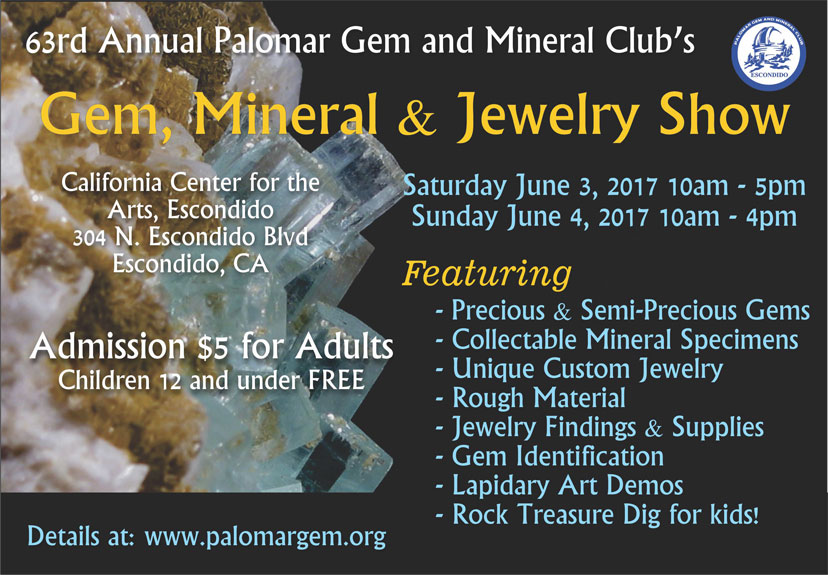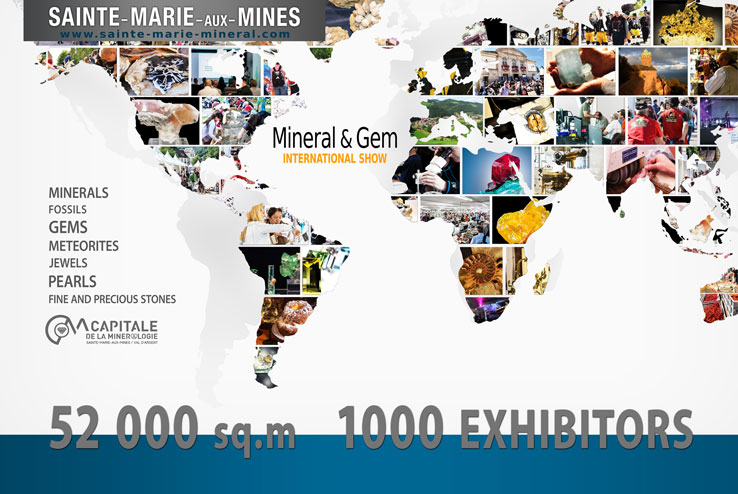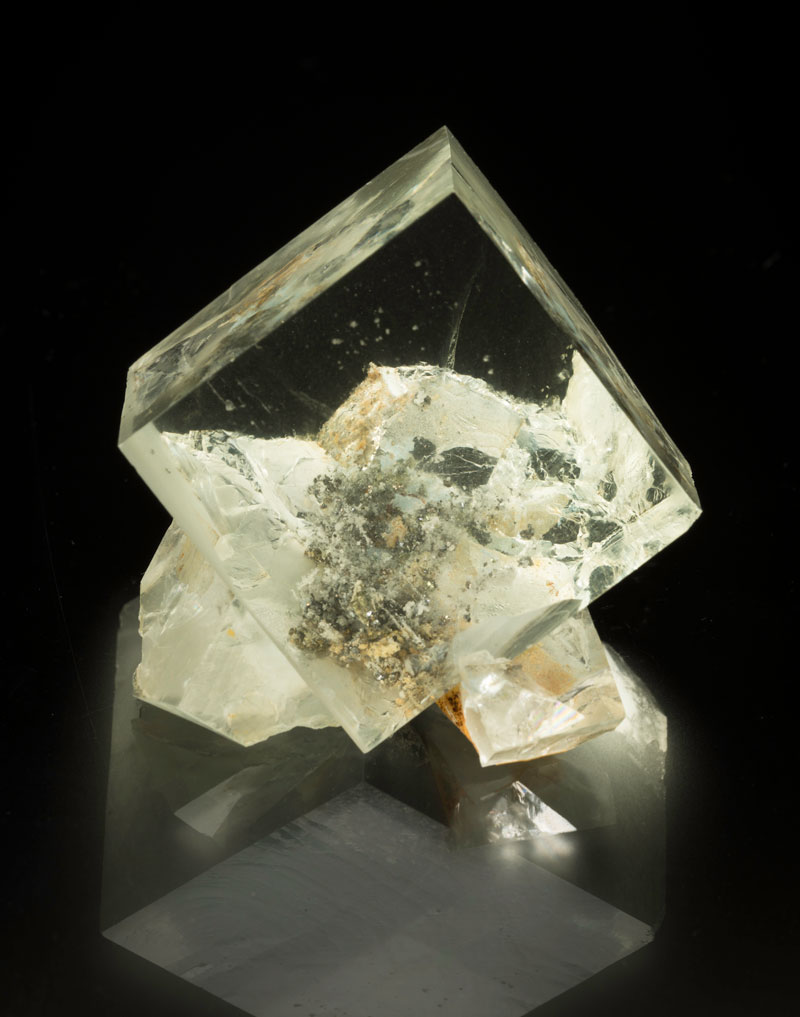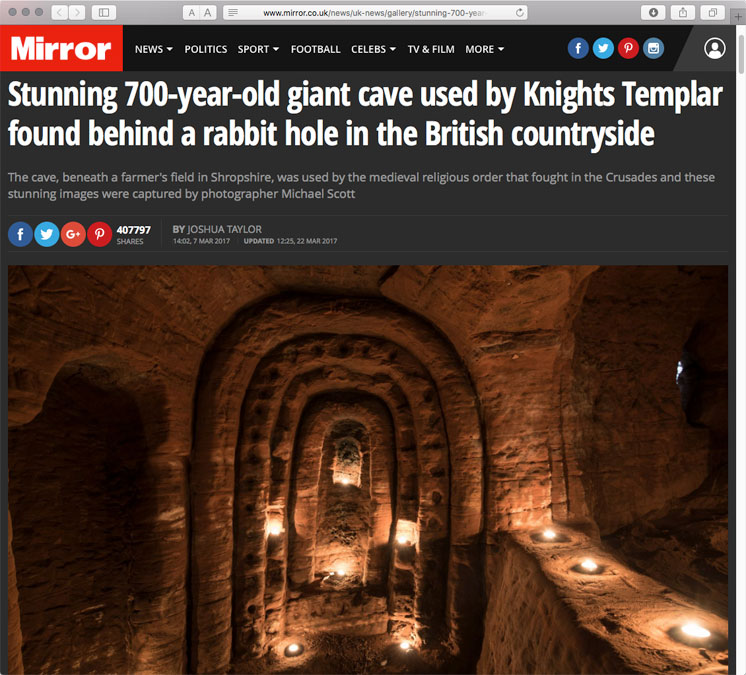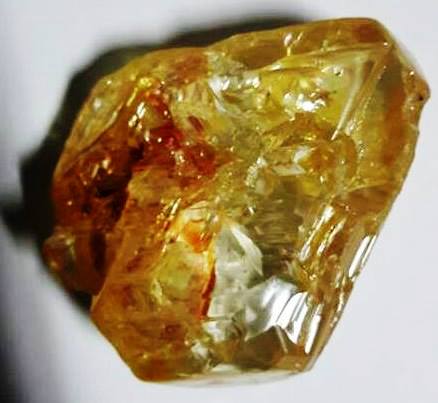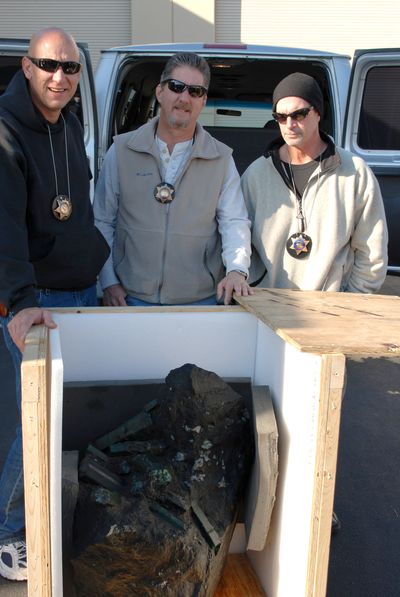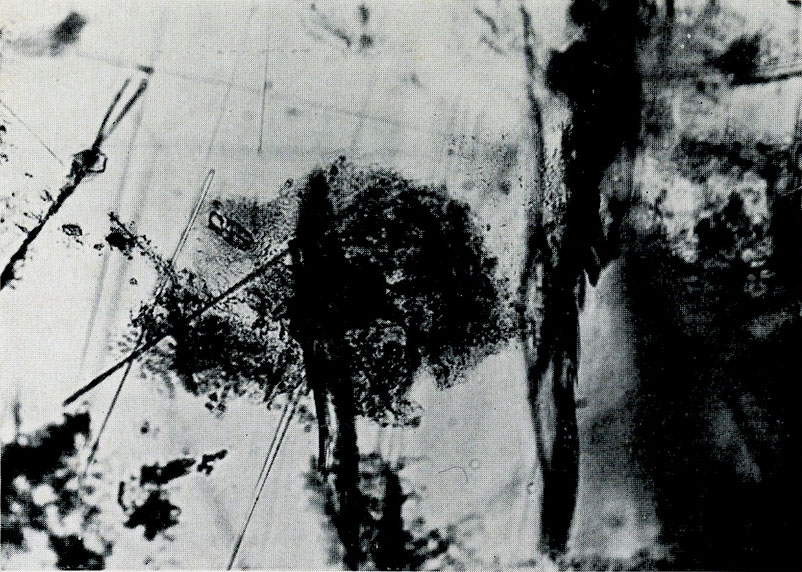April 2017
Abraham Poincheval spent a week living inside a 12-tonne limestone boulder in a Paris art gallery. Report by Victoria Laurence. The performance of Pierre (Stone) by Abraham Poincheval took place at the Paris "anti-museum" Palais de Tokyo February 22 to March 1.
Table of Contents
Shows and Events
- Do Diamonds Matter?: A Panel Discussion April 5
- Sotheby's Hong Kong: Curiosity III April 4
- NY/NJ Mineral, Fossil, Gem and Jewelry Show: April 7–9, 2017
- Texas Fine Mineral Show: April 28–30, 2017
- 63rd Annual Palomar Gem, Mineral & Jewelry Show: June 3–4, 2017
- Mineral & Gem à Sainte-Marie-aux-Mines: June 22–25, 2017
- Dallas Mineral Collecting Symposium, Aug. 25–28, 2017
Pala International News
Minerals and Mineralogy News
Industry News
Books
- Mines of the American West
by Ivan Herring
Recycle Bin
- Marcial de Gomar Collection On the Block
- The Curse of the Bahia Emerald
- Emeralds from Sandawana
by Eduard J. Gübelin
For Fun…
Editor: David Hughes
Shows and Events
Do Diamonds Matter?
A Panel Discussion April 5
Ah, the lowly diamond, brushed aside by aesthetes of fine colored gemstones. If that sums up your own attitude, a panel discussion at Harvard University may be just the thing. "Do Diamonds Matter?" explores that question with an octet of opiners.
- Raquel Alonso-Perez, Ph.D., FGA,
Curator, Mineralogical & Geological Museum - Alan Bronstein,
President Natural Color Diamond Assoc (NCDIA) - Brandee Dallow,
WJA International Board President - Alan Hart, FGA, CDA,
CEO Gemological Assoc of Great Britain, London - Adonis Pouroulis,
Chairman Petra Diamonds, London - Gary Roskin, G.G. (GIA) FGA,
Exec Dir, International Colored Gemstones Association, New York - Jennifer Schloss,
Physics Ph.D. Candidate, Physics, Harvard University, MIT (Dual) - Moderator: Emily Stoehrer, Ph.D.
Rita J. Kaplan and Susan B. Kaplan Curator of Jewelry, Museum of Fine Arts, Boston
The event is jointly sponsored by the Women's Jewelry Association and the Mineralogical and Geological Museum, Harvard University, where it will be held.
The discussion, which is free, is followed by a reception that requires only your RSVP.
Sotheby's Hong Kong: Curiosity III April 4
In Denver our Museum of Contemporary Art hosts a summertime lecture series titled Mixed Taste: Tag Team Lectures on Unrelated Topics. For instance, last August 5 the topics were Merle Haggard & The History of Dinner. Such is the eclecticism of the Sotheby's Hong Kong April 4 sale Curiosity III, which the auction house bills as a
cabinet of curiosity offer[ing] an improbable array of objects from the dawn of life on earth to the present day, including snow goggles from the ancient Chukchi tribe living in the Arctic tundra; the massive skull of a late Jurassic allosaurus; a magnificent and extremely rare large 8th century head of a Bodhisattva made in the dry lacquer technique; fine scholar’s rocks and roots; a study of skulls and limbs by Renaissance master Figino; a wonderful selection of naturally formed gogottes; understated monochrome stoneware vessels from the Song dynasty; and a beautiful anatomical wax head made in Italy more than two hundred years ago.
Using the objects featured in the April 4 Curiosity III sale in Hong Kong, Nicolas Chow, Sotheby's deputy chairman, Asia, pays homage to early 20th-century European experimental filmmakers in this Super-8 short. Look for fleeting images of several Fontainebleau concretion specimens on offer.
The mineral enthusiast's interest will be piqued by several items. Five gogottes (sandstone concretions) from Fontainebleau (lots 3010, 3023, 3036, 3057), three gray "ying" rocks (viewing stones) from the Ming–Qing Dynasty (3013, 3060, 3044), a lingbi rock (viewing stone from Lingbi, Anhui province) from the Yuan–Ming Dynasty (3018), and an aragonite concretion from Morocco (3040).
As the film above might suggest, the catalog for this sale is itself a work of art, employing composite montage spreads that hold the eye, just as do all the individual objects in this sale. Fortunately for the those short of cash, a PDF of the catalog is available for free download (look for the download icon).
NY/NJ Mineral, Fossil, Gem and Jewelry Show: April 7–9, 2017
East Coast dwellers may not know that Eons Expos, the same team that puts on the Denver Coliseum Mineral, Fossil and Gem Show as well as the Tucson 22nd Street Mineral and Fossil Show, also hosts a third: the NY/NJ Mineral, Fossil, Gem and Jewelry Show held in Edison, New Jersey at the New Jersey Expo Center. This year's show will be held this coming weekend, April 7–9.
New special exhibitions will include:
- The Evolving Universe from the Smithsonian Institution
- The 76-panel Picturing Science, seen for the first time outside the American Museum of Natural History
- The Franklin Mineral Museum's exhibit of fluorescent minerals, the museum's specialty
Expected are 350–400 vendor booths and up to 20,000 visitors. A 20,000-square-foot "wholesale only" space for B2Bers will be available. There's even a reduced hotel rate.
Texas Fine Mineral Show: April 28–30, 2017
The Houston Fine Mineral Show moves this year about thirty miles north of city center to Shenandoah and with that is rebranded as the Texas Fine Mineral Show. It's being held at the Holiday Inn & Suites Shenandoah – The Woodlands.
63rd Annual Palomar Gem, Mineral & Jewelry Show: June 3–4, 2017
Late this spring the Palomar Gem and Mineral Club hosts its sixty-third annual Palomar Gem, Mineral & Jewelry Show at the California Center for the Arts in downtown Escondido, California. The club is as old as the show, having been founded on March 20, 1954. So they've learned a thing or two over the years. Thirty vendors are expected at the show, which is in part a fundraiser for the club's activities, including field trips, workshops, and faceting and other specialty classes.
Club member Archie J. Kuehn, who owns the San Diego Tourmaline Mine in Mesa Grande, told us, "I think our show is the finest gem and mineral show in the San Diego area, and each year we are upgrading it. The Center for the Arts is an ideal location. This year we want to feature the rich gem and mineral history of San Diego."
For more on the show and the Palomar Gem and Mineral club, visit their website.
Mineral & Gem à Sainte-Marie-aux-Mines: June 22–25, 2017
The 54th Sainte-Marie show will be held June 22–25, with the first two days limited to the trade only. This year Bill and Will Larson will attend the show along with friend and fellow gem dealer Mark Kaufman. Details for 2017 haven't yet been posted, but they usually appear first on the French-language version of the website. (You can easily translate websites using the Chrome web browser or Google's translation tool.)
Visitors can expect more than a thousand exhibitors as well as special exhibitions, lectures, a gem fashion show, workshops, activities for kids, and hopefully a symposium. For now, a streaming video of the sights from last year's show.
Florilège d'images de l'édition 2016 du salon Mineral & Gems de Sainte-Marie-aux-Mines par Terralia-Concept. (Images of the 2016 edition of the Mineral & Gems show from Sainte-Marie-aux-Mines by Terralia-Concept.
Dallas Mineral Collecting Symposium, Aug. 25–28, 2017
The Dallas Mineral Collecting Symposium is once again held in the Charles W. Eisemann Performing Arts Center this year in August. Accommodations at the Renaissance Dallas Richardson Hotel are available at a reduced rate. The Rosewood Mansion on Turtle Creek is an alternate option.
A world-class lineup of experts is slated for the symposium. You won't want to miss it!
Emanuele Marini
Mineral Lab Advances and Philosophies
Biography and Lecture Synopsis
Richard Hughes
Ruby and Sapphire
Biography and Lecture Synopsis
Dr. Robert Hazen
Mineral Evolution and Diversity
Biography and Lecture Synopsis
George Rossman
Color in Minerals
Biography and Lecture Synopsis
John Cornish
Australian Crocoite Mining
Federico Barlocher
Gem Minerals of Burma
Christophe Keilmann
History of the Munich Show
Biography and Lecture Synopsis
Bruce Bridges
The Tsavorite Story
Biography and Lecture Synopsis
Dr. Peter Lyckberg
Pakistani Gem Treasures
Biography and Lecture Synopsis
Pala International News
Pala's Featured Specimen
This month we feature a wonderful older fluorite specimen from Dal'negorsk that has galena inclusions in the center of the main cube. Looking into this fine gemmy fluorite is like beholding a world of its own. Fluorites from Dal'negorsk are enjoyed by many collectors for their flawlessness and razor-sharp edges. Add this fine piece to your collection.
Rus in urbe. Fluorite with galena inclusions from the Nikolai mine, Dal'negorsk, Primorkiy, Kray, Far-East region, Siberia, Russia, 5 x 4.5 x 3.5 cm. Price available upon request. (Photo: Mia Dixon)
Interested? Contact us.
Mineral and Mineralogy News
Naica Crystal Critters
You've seen the pictures: tiny figures scrambling like ants over impossibly large crystals. It was ten years ago this month that we called readers' attention to them in a story called "Honey, I Shrunk the Geologist."
In February the Naica caves of Mexico were back in the news, but for a new reason. At a meeting of the American Association for the Advancement of Science, NASA Astrobiology Institute director Penelope Boston discussed that the Naica crystals contain "dormant but viable" microbes, as reported by National Geographic.
These biological Rip Van Winkles have been cutting the Zs for many millennia, and there's the rub. Microbes of such mettle could possibly withstand sterilization efforts by NASA of its spacecraft. Is there life on Mars? A positive answer could be misleading if such life were carried from Earth by the spacecraft itself.
Having harvested crystals containing fluid pockets in the late 2000s, Boston and her team bestirred the beensie beasties, cultivating cultures, which continue to grow. The organisms are genetically discrete from any other Earth creatures but are not unlike those found in similar inhospitable environments.
While Boston's study has yet to be peer reviewed, a microbiologist at the University of Florida, Brent Christner, said microbes have been resuscitated from geological materials hundreds of thousands to millions of years old. Others are skeptical, with French National Center for Scientific Research microbiologist Purificación López-García suggesting that the cultured organisms themselves might merely be contaminants from crystal surfaces. That is countered by Boston, who said her team took measures to prevent contamination and, besides, the microbes from the fluid inclusions are different genetically from those in the outer (relatively speaking) environment.
And Related…
Researchers led by Matthew S. Dodd of the London Centre for Nanotechnology make the case in the journal Nature for having identified the world's oldest fossils, according to an AP story.
Remains of microorganisms at least 3,770 million years old have been discovered by an international team led by UCL scientists, providing direct evidence of one of the oldest life forms on Earth. Tiny filaments and tubes formed by bacteria that lived on iron were found encased in quartz layers in the Nuvvuagittuq Supracrustal Belt (NSB), Quebec, Canada. Read more here »
Tubules and filaments in rock found on the eastern shore of Hudson Bay in northern Quebec contain the remains of what could be bacteria that lived 3.77 to 4.28 billion years ago. That outdoes slightly the 3.7 billion-year record set last August by some Greenland rock features. Again, this territory comes with skeptics—including the researcher who reported on the Greenland find.
And Distantly Related…
Others, I am not the first,
Have willed more mischief than they durst
—A Shropshire Lad, A. E. Housman
Since we were on the subject of caves, we couldn't resist pointing to news of a network of manmade sandstone caves in Shropshire, England, which hit the the cybersphere last month. Fashioned like a subterranean temple, much was made about the medieval origin of the rooms, even hearkening back to the Middle Ages and the Knights Templar. Leave it to Snopes to offer a more prosaic proposition: the network likely is what's known in the old country as a folly, defined by our dictionary as "a costly ornamental building with no practical purpose, especially a tower or mock-Gothic ruin built in a large garden or park." Such things were fashionable in Victorian times and show that the artist Christo had his antecedents.
Don't believe everything you read in the paper.
Author Steve Powell issued a book, Subterranean Shropshire, after he became alarmed at "how quickly Shropshire's hidden heritage, or subterranean places, were decaying or being destroyed by various means, either natural or through vandalism, with the knowledge and history of these places passing only by word of mouth."
A is for Anthropocene
Last April scientist Robert M. Hazen appeared in our pages as having expressed how rare most of Earth's minerals are. Our planet's crust is composed almost entirely of a hundred minerals, leaving the other 4,900 rare and half of those extremely rare. Last month Hazen published a study along with Edward S. Grew, Marcus J. Origlieri and Robert T. Downs with the intriguing title "On the mineralogy of the 'Anthropocene Epoch'." The A-word may be familiar in the context of climatology, but not so with mineralogy. Simply stated, for millennia the distribution of minerals by humans over long distances was relatively limited, as were mineral compounds. That changed with the industrial revolution in manufacturing and mining.
The study identifies at least three kinds of human activities in this regard. The first is the creation of synthetic mineral-like compounds for intentional use (examples given are yttrium aluminum garnet crystals used in lasers and Portland cement). Incidental mineralization of mine tunnels and pipes is another result of manmade ventures. A second activity is the removal of large portions of rocks and minerals such as quarries and open-pit mines. The third occurrence is obvious to mineral and gemstone enthusiasts. All of this could be confusing to a scientist digging around in the 101st century.
A case in point. Shown here are colorless fiedlerite crystals, the byproduct of lead mining in Lavrio, Greece in classical times. Slag from the mining was dumped into the Mirtoan Sea and over the years reacted with the water to form minerals like this one, found only in particular slag localities. (Photo: RRUFF)
For a detailed look at this new study, see this story in Forbes and this news item from Dr. Hazen's Geophysical Laboratory, Carnegie Institution.
Super Squeeze Reveals Mineral Might
Diamonds to squeeze a sample to ultrahigh pressures corresponding to those of the Earth's core (greater than 135 gigapascals). The samples are heated under pressure to high temperatures of the core (about 4,000 kelvins and higher) by being irradiated by a laser through diamonds. (Photo: ELSI news release)
The exact composition of Earth's core has been contended for some time. Yes, it's molten metal—iron and a little nickel. But ten percent of the core consists of "light" elements including silicon, oxygen, sulfur, carbon, hydrogen, according to Kei Hirose, Director of the Earth-Life Science Institute at Tokyo Institute of Technology. It's the proportion of each in the mix that was an open question until a new study.
Hirose's lab used a laser-heated diamond-anvil cell to enclose a range of alloy samples in dust form, with pressure and heat simulating those of the Earth's core. Prior experiments had only been conducted using iron and a single alloy. Hirose's lab used iron, silicon and oxygen. That sample formed silicon dioxide crystals, which when fused become what we know as quartz. It is the crystallization of silicon dioxide that appears to power the Earth's magnetic field.
"Even if you have silicon present, you can't make silicon dioxide crystals without also having some oxygen available" says ELSI scientist George Helffrich, who modeled the crystallization process for this study, according to the institute's news release. "But this gives us clues about the original concentration of oxygen and silicon in the core, because only some silicon:oxygen ratios are compatible with this model."
The study is published in the March 2, 2017 (No. 543, pp. 99–102) edition of Nature. For a layperson's overview, see "'Quartz' crystals at the Earth's core power its magnetic field" at the Tokyo Institute of Technology website.
Wulfenite Wins!
Glassy wulfenites on matrix from its classic locality, the Red Cloud Mine of Arizona. Largest crystal has some damage but displays well. Inventory #17807. (Photo: John McLean)
Mineral history was made in Arizona on March 22 when Governor Doug Ducey signed HB 2092 making wulfenite the official state mineral. It joins copper as the state metal and turquoise as the official gemstone. The two-year effort received a vote of 57 ayes, 1 nay, 2 abstentions in the House, with the Senate voting 28-1-1 earlier this year according to the legislative record.
Rep. Mark Finchem (R-Oro Valley), who introduced the bill, said that wulfenite was more abundant in Arizona than copper, as reported by the Arizona Republic. Finchem was approached by the Arizona Geological Survey with the idea of a state mineral. At one point he wowed a House hearing with a football-sized specimen.
Wulfenite got a makeover in 1845 when it was renamed in honor of Franz Xavier von Wulfen (1728–1805) a Jesuit botanist, mineralogist and alpinist, per the stone's profile on Mindat. The original name in Latin didn't exactly roll off the tongue: "plumbum spatosum flavo-rubrum." It also had been known as carinthite after its type locality of Carinthia, Austria.
Industry News
Himalaya History
Mark Ivan Jacobson has published a three-part study, "The Early History of the Himalaya Pegmatite Mine, San Diego County, California," in the pages of Mineral News: The Mineral Collector's Newsletter. It appears in the first three editions of 2017, with the promise of more to come.
Jacobson is with the Colorado School of Mines Geology Museum and specializes in pegmatites. The study's abstract reads:
The gem tourmaline mining history of the Himalaya mine in San Diego County is described and documented from 1872 to 1913 recounting the activity of Lippman Tannenbaum, Jethro Goodman Braye, Charles Russell Orcutt and a cast of many other flamboyant characters in more detail than has ever been provided before. Due to the article's length it is being published serially.
Diamond News
Finders Keepers
On March 11, 14-year-old Kalel Langford scooped up a 7.44-carat brown diamond at Crater of Diamonds State Park in Arkansas according to a park news release. The lucky lad, from Centerton four miles to the north, had made the trip south not just for hunting diamonds but also for a baseball tournament. Its color so dark, Kalel and his father Craig weren't even sure the stone was a diamond, and they kept searching. When they had their finds identified before leaving the park, Kalel was told he'd uncovered the seventh largest diamond found in the park since 1972.
"Conditions were ideal for Kalel to find his diamond," said Park Interpreter Waymon Cox. "About an inch of rain fell on the plowed search area during the week. A heavy rain can uncover larger diamonds near the surface. Diamonds have a metallic-looking shine and are often easier to spot on top of the ground." (Photo: Crater of Diamonds State Park news release)
Kalel is calling the gemstone Superman's Diamond since he unwittingly shares that superhero's birth name Kal-El (changed to Clark in the DC Comics series). Kalel is holding onto his diamond as a souvenir of his first visit to the park.
Finders Keepers
Four days after Kalel Langford found his prized diamond, Sierra Leone pastor Emmanuel A. Momoh uncovered a diamond roughly a hundred times that size. According to a Telegraph story March 16 Momoh actually ministers to miners in the Kono District in the eastern part of the country. Alluvial mining supplements his income.
At 706 carats this is thought to be the thirteenth largest diamond ever extracted. (Photo: Sierra Leone State House news release)
Momoh won't be keeping his find as a souvenir, however. According to a State House news release the diamond was turned over to President Ernest Bai Koroma by Paramount Chief Paul N. Saquee The 5 of the Tankoro Chiefdom in Kono. "Receiving the diamond President Koroma thanked the chief and his people for not smuggling the diamond out of the country," the release stated. The diamond was to be auctioned, with Momoh being remunerated.
Books
Mines of the American West
by Ivan Herring
You can have a peek at the San Diego County edition of Mines of the American West on Amazon.
Last year we introduced our readers to author Ivan Herring, whose writing began as a collection of all the information regarding mines and minerals during his forty-year career as a purchaser of raw materials in manufacturing. (Herring has devoted books to sideline topics as well; see our article from February 2016.)
Herring's Mines of the American West series was offered on the Kindle platform, but he wrote us last month to say that, due to numerous requests, he is now issuing the books in paperback format. The California counties that are covered in this group are Los Angeles, San Diego, Imperial, Ventura, and Orange.
Herring tells us that if he receives demand for paperbacks of other titles he will consider it, but for now they are available as Kindle e-books.
Recycle Bin
As we often do, here we offer items from our sibling e-publication, Palagems Reflective Index.
Emerald Aisle
Last month on Palagems.com we marked Saint Patrick's Day with three items of interest to both mineral aficionados as well as gemstone enthusiasts.
Marcial de Gomar Collection On the Block
New York City-based auction house Guernsey's is poised for a sale of the Marcial de Gomar Emerald Collection on April 25. The sale catalog below takes you through three baker's dozens of lots, featuring both rough and cut stones as well as set jewels, coins, a 22.5-carat conch pearl, and a "red emerald."
Marcial worked for years in the mines of Muzo, Colombia, so he had access to emerald specimens like La Gloria (pictured on the catalog cover), weighing 887 carats and believed to be the largest such specimen in the United States. Marcial's collection also contains the largest group of cut emeralds from the sunken galleon Nuestra Señora de Atocha, which he received as partial payment for his consultation on the excavation of the ship's treasure.
For more information on the sale, see the Guernsey's website.
The Curse of the Bahia Emerald
Cops and robbed? Scott Miller, Mark Gayman, and Lt. Tom Grub, of the Los Angeles Sheriffs Department, show off the swag in 2008. (Photo: L.A. Sheriffs Dept.)
For those of our readers overly familiar with the saga of the "Bahia" Emerald, which we began covering eight years ago, a new profile of the cursed specimen in Wired might be only notable for its Crazy Color illustrations. But if the specimen's story is a little hazy, you're in for an engaging tale.
The last time we looked at the fate of this specimen was our 2015 St. Patrick's Day edition of Emerald Aisle via a recently published Bloomberg article, which we called "perhaps the most comprehensive story on the specimen to date." That article ended with a punch line: Bahia Emerald contender Ken Conetto showing the Bloomberg reporter a photo of another specimen, which he claimed was "four times bigger" than the Bahia Emerald. In this month's Wiredarticle, after a description of Conetto's mobile home worthy of Raymond Carver, journalist Elizabeth Weil finds him still dissing the specimen as a reeking rucksack of Russian pinniped pucky, or something to that effect. And Jerry Ferrara, who is still very much emotionally invested in the specimen, after initially declining to talk with Weil, sent her a copy of his unpublished memoir and invited her to visit him in Florida, which leads to a lot of local color. The fate of the Bahia Emerald? Weil gives that away up front. But do read "The Curse of the Bahia Emerald, a Giant Green Rock That Ruins Lives."
Emeralds from Sandawana
By E. J. Gübelin, Ph.D., C.G., F.G.A.
With Pala Presents, we offer selections from the library of Pala International’s Bill Larson, who shares some of the wealth of information in the realm of minerals and mineralogy.
In this age of on-demand printing and "free" business cards we forget what a luxury full-color was in earlier times. Even monochrome came at a price. When your editor first worked in the chartroom of the Kaiser Permanente medical center in Hollywood in 1978, our unit had a photocopy gatekeeper. None of us clerks could copy so much as a lab slip without giving it to the Xerox czar. At the same period of time, the DIY aesthetic took us to commercial color copiers that did lo-fi reproductions by default. I was reminded of this a couple of weeks ago when viewing Basquiat Before Basquiat: East 12th Street, 1979–1980 at MCA Denver, which includes several of the late artist's color Xerox works. Now an artist would have to tweak the machine to get that crappy, edgy effect. And, for those old enough to remember, many monochrome-copied photographs were rendered at their most basic: black and white, with almost nothing in between.
All of this came back to me when preparing this month's Pala Presents offering: "Emeralds From Sandawana" by the late maestro of the microworld Eduard J. Gübelin. This study of verdurous beryl from what is now south-central Zimbabwe is in the collection of Bill Larson as a fifteen-page reprint. Open the cover and you are dazzled by a sextet of brilliant full-color photomicrographs of emerald inclusions. Browse further into the text and seven more monochrome figures cry out for color, like those lame Xeroxes of the late '70s. Figure 4, reproduced here, depicts a garnet crystal surrounded by a "brownish" halo. Fortunately the full-color images up front depict the same phenomenon.
Strongly resorbed garnet crystal surrounded by a brownish, dusty halo. 125 x.
"Emeralds From Sandawana" takes a comprehensive look at the subject, first following prospectors Laurence Contat and Cornelius Oosthuizen who had been lured to the area by offers made by the Rhodesian government. Once they hit a rich deposit—sending $15,000 worth of emeralds to New York—the government got savvy. Dr. Gübelin was then asked to examine these emeralds "in order to find out their local peculiarities" and so he takes the reader through the headings of Occurrence, Appearance, Chemical Composition, Physical Properties and, of course, what the Doctor is famous for, Internal Characteristics.
Read "Emeralds from Sandawana" by Eduard J. Gübelin.
For Fun…
We've all seen geode cakes and pastries, right? How about a whole amethyst geode confection? Culinary Institute of America student Alex Yeatts did just that. So let's get crackin'.
— End April Newsletter • Published 4/3/17 —
We welcome your feedback.




